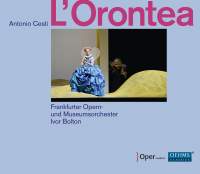Texte paru dans: / Appeared in: |
|
|
Outil de traduction ~ (Très approximatif) |
|
|
Reviewer: Barry
Brenesal
Antonio Cesti (1623–1669) is
an infrequent visitor to our pages. In his lifetime, however, he was
considered one of the leading operatic composers in the Italian States, and
the successor to Francesco Cavalli. Originally destined for the minor
religious orders, valued as a church organist and for his superlative tenor
voice, his abilities as a composer were noticed by the opera-mad Ferdinand
Karl, Archduke of Austria, who wanted to make Innsbruck a center for Italian
opera comparable to Venice, Florence, and Mantua. He arranged for Cesti to
be released for five years from his clerical responsibilities, and engaged
him as both as his court director of secular music and impresario of his new
opera company.
Though Ferdinand proved an
inept financial manager, his musical choices were almost invariably
inspired. In the case of Cesti, he fastened upon an excellent talent. After
two operas written for Venice’s carnival season, the composer worked on a
series of six new operas for Innsbruck (and another, Cleopatra, a revision
of his Venetian Il Cesare amante) that formed his reputation both at court
and abroad. L’Orontea, premiered in 1656, was the third of his original
operas for Innsbruck. It would prove a hit that received nearly 20 revivals
over the next 30 years, and furnished one selection that survived changes of
style and taste into the 20th century as a handful of so-called antiche arie:
“Intorno all’ idol mio.”
The opera has been recorded
before. René Jacobs’s revival in the early 1980s was reviewed
enthusiastically in Fanfare 6:4 by Anthony Coggi. He only took exception to
the plot, which he found “exceedingly convoluted” even by the contemporary
standards. In synopsis, I’ve found that nearly every Baroque opera is, but
have yet to encounter one in live performance that, with all of its
admittedly lengthy recitative intact, doesn’t make sense over its entire 3–4
hour length. That of L’Orontea is no worse than the rest, by turns
frivolous, cynical, melancholy, and insightful, though inclining far more to
the lighter side of the emotional spectrum than Monteverdi or even much of
Cavalli. It also represents a further development of Italian opera in the
17th century, draining recitatives of musical interest, and establishing
arias as time-halted moments of emotional expression.
On one important issue, at
least, the liner notes by Steffi Mieszkowski for this Frankfurt Opera
production slyly stack the deck. She mentions the need for a male alto for
the role of Gelone—a role that also requires a bass-baritone, because the
copy of the manuscript score now at Wellesley College shows the part written
in different sections for these two registers. She neglects to mention that
it’s only one of four extent Italian manuscript score copies of L’Orontea,
that the one Frankfurt chose is regarded as corrupt by a number of
musicologists, and that in the other three, Gelone is assigned throughout to
the bass range. Whether Frankfurt’s solution, which posits the alto-falsettist
as the part’s “sober” voice and baritone as its “drunken” works or not, it
shouldn’t be stated in the liner notes as though it were a fait accompli,
when it is at best a fait contesté.
The cast is middling, though
in fairness to several of the performers whose work I’m familiar with from
other recordings and live performances, this may be a matter of artistic
(and more specifically, stage managed) direction. For instance, Paula
Murrihy, possessor of a rich mezzo-soprano voice, here drains the vibrato
during much of her performance while swelling the start of many phrases. The
result in arias such as the aforementioned “Intorno all’ idol mio” is rather
like listening to a boy soprano with poor vocal production. Louise Alder in
turn uses dynamics to good effect and phrases well, but has problems moving
her soprano over even relatively slow fioritura. Matthias Rexroth, whom I
thought came across as a stereotype of bad counter-tenors in Gluck’s Ezio (Coviello
20713; Fanfare 32:1), is no better here: poor intonation, sagging tone, no
enunciation of the text. Xavier Sabata as Alidoro is far better, phrasing
and enunciating well, though like many countertenors he cannot color his
tone. Simon Bailey’s alto in turn cannot compare to his bass-baritone notes.
That fine tenor Guy de Mey is given the role of Aristea, Alidoro’s supposed
mother—and as this is a comic turn, he explodes some consonants and huffs
through fast passagework. There’s no scholarship supporting any of this
exaggerated business, though we’ve seen and heard it repeatedly in recent
years in lighter parts. Bolton is, as ever, disciplined and energetic. Too energetic on occasion, I find; for his range of tempo is limited, and shaded always to the fast side. By contrast, Jacobs allowed the pensive selections to make their emotional points without being pressed so hard, while remaining flexible enough in the secco recitatives to actually render them interesting—no mean feat, that. His cast, which included Gregory Reinhart, Isaabelle Poulenard, Gastone Sarti, and Helga Müller-Molinari, is superior in most instances to the one Frankfurt amassed. Unfortunately, Harmonia Mundi has not chosen to rerelease physical copies of L’Orontea, issuing digital downloads instead. Despite this, Jacobs’s recording remains the more theatrically engaging and thoroughly musical exploration of Cesti’s score. | |
|
Support us financially by purchasing this disc from eiher one of these suppliers. Un achat via l'un ou l'autre des fournisseurs proposés contribue à défrayer les coûts d'exploitation de ce site. |
|
|
|
|
|
Cliquez l'un ou l'autre
bouton pour découvrir bien d'autres critiques de CD |
|




